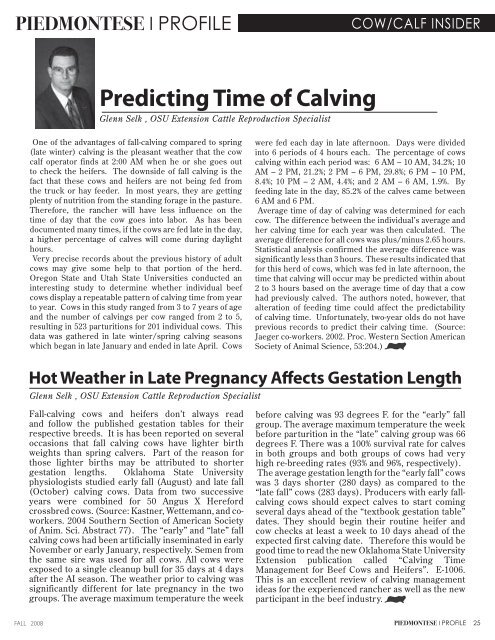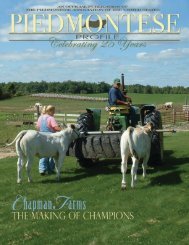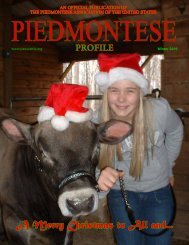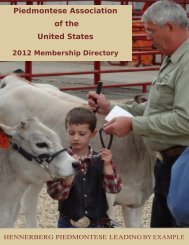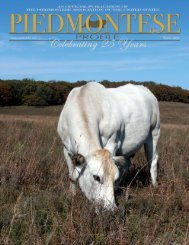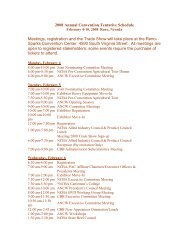I edmontese - Piedmontese Association of the United States
I edmontese - Piedmontese Association of the United States
I edmontese - Piedmontese Association of the United States
You also want an ePaper? Increase the reach of your titles
YUMPU automatically turns print PDFs into web optimized ePapers that Google loves.
PIEDMONTESE | PROFILE<br />
COW/CALF INSIDER<br />
Predicting Time <strong>of</strong> Calving<br />
Glenn Selk , OSU Extension Cattle Reproduction Specialist<br />
One <strong>of</strong> <strong>the</strong> advantages <strong>of</strong> fall-calving compared to spring<br />
(late winter) calving is <strong>the</strong> pleasant wea<strong>the</strong>r that <strong>the</strong> cow<br />
calf operator finds at 2:00 AM when he or she goes out<br />
to check <strong>the</strong> heifers. The downside <strong>of</strong> fall calving is <strong>the</strong><br />
fact that <strong>the</strong>se cows and heifers are not being fed from<br />
<strong>the</strong> truck or hay feeder. In most years, <strong>the</strong>y are getting<br />
plenty <strong>of</strong> nutrition from <strong>the</strong> standing forage in <strong>the</strong> pasture.<br />
Therefore, <strong>the</strong> rancher will have less influence on <strong>the</strong><br />
time <strong>of</strong> day that <strong>the</strong> cow goes into labor. As has been<br />
documented many times, if <strong>the</strong> cows are fed late in <strong>the</strong> day,<br />
a higher percentage <strong>of</strong> calves will come during daylight<br />
hours.<br />
Very precise records about <strong>the</strong> previous history <strong>of</strong> adult<br />
cows may give some help to that portion <strong>of</strong> <strong>the</strong> herd.<br />
Oregon State and Utah State Universities conducted an<br />
interesting study to determine whe<strong>the</strong>r individual beef<br />
cows display a repeatable pattern <strong>of</strong> calving time from year<br />
to year. Cows in this study ranged from 3 to 7 years <strong>of</strong> age<br />
and <strong>the</strong> number <strong>of</strong> calvings per cow ranged from 2 to 5,<br />
resulting in 523 parturitions for 201 individual cows. This<br />
data was ga<strong>the</strong>red in late winter/spring calving seasons<br />
which began in late January and ended in late April. Cows<br />
were fed each day in late afternoon. Days were divided<br />
into 6 periods <strong>of</strong> 4 hours each. The percentage <strong>of</strong> cows<br />
calving within each period was: 6 AM – 10 AM, 34.2%; 10<br />
AM – 2 PM, 21.2%; 2 PM – 6 PM, 29.8%; 6 PM – 10 PM,<br />
8.4%; 10 PM – 2 AM, 4.4%; and 2 AM – 6 AM, 1.9%. By<br />
feeding late in <strong>the</strong> day, 85.2% <strong>of</strong> <strong>the</strong> calves came between<br />
6 AM and 6 PM.<br />
Average time <strong>of</strong> day <strong>of</strong> calving was determined for each<br />
cow. The difference between <strong>the</strong> individual’s average and<br />
her calving time for each year was <strong>the</strong>n calculated. The<br />
average difference for all cows was plus/minus 2.65 hours.<br />
Statistical analysis confirmed <strong>the</strong> average difference was<br />
significantly less than 3 hours. These results indicated that<br />
for this herd <strong>of</strong> cows, which was fed in late afternoon, <strong>the</strong><br />
time that calving will occur may be predicted within about<br />
2 to 3 hours based on <strong>the</strong> average time <strong>of</strong> day that a cow<br />
had previously calved. The authors noted, however, that<br />
alteration <strong>of</strong> feeding time could affect <strong>the</strong> predictability<br />
<strong>of</strong> calving time. Unfortunately, two-year olds do not have<br />
previous records to predict <strong>the</strong>ir calving time. (Source:<br />
Jaeger co-workers. 2002. Proc. Western Section American<br />
Society <strong>of</strong> Animal Science, 53:204.)<br />
Hot Wea<strong>the</strong>r in Late Pregnancy Affects Gestation Length<br />
Glenn Selk , OSU Extension Cattle Reproduction Specialist<br />
Fall-calving cows and heifers don’t always read<br />
and follow <strong>the</strong> published gestation tables for <strong>the</strong>ir<br />
respective breeds. It is has been reported on several<br />
occasions that fall calving cows have lighter birth<br />
weights than spring calvers. Part <strong>of</strong> <strong>the</strong> reason for<br />
those lighter births may be attributed to shorter<br />
gestation lengths. Oklahoma State University<br />
physiologists studied early fall (August) and late fall<br />
(October) calving cows. Data from two successive<br />
years were combined for 50 Angus X Hereford<br />
crossbred cows. (Source: Kastner, Wettemann, and coworkers.<br />
2004 Sou<strong>the</strong>rn Section <strong>of</strong> American Society<br />
<strong>of</strong> Anim. Sci. Abstract 77). The “early” and “late” fall<br />
calving cows had been artificially inseminated in early<br />
November or early January, respectively. Semen from<br />
<strong>the</strong> same sire was used for all cows. All cows were<br />
exposed to a single cleanup bull for 35 days at 4 days<br />
after <strong>the</strong> AI season. The wea<strong>the</strong>r prior to calving was<br />
significantly different for late pregnancy in <strong>the</strong> two<br />
groups. The average maximum temperature <strong>the</strong> week<br />
before calving was 93 degrees F. for <strong>the</strong> “early” fall<br />
group. The average maximum temperature <strong>the</strong> week<br />
before parturition in <strong>the</strong> “late” calving group was 66<br />
degrees F. There was a 100% survival rate for calves<br />
in both groups and both groups <strong>of</strong> cows had very<br />
high re-breeding rates (93% and 96%, respectively).<br />
The average gestation length for <strong>the</strong> “early fall” cows<br />
was 3 days shorter (280 days) as compared to <strong>the</strong><br />
“late fall” cows (283 days). Producers with early fallcalving<br />
cows should expect calves to start coming<br />
several days ahead <strong>of</strong> <strong>the</strong> “textbook gestation table”<br />
dates. They should begin <strong>the</strong>ir routine heifer and<br />
cow checks at least a week to 10 days ahead <strong>of</strong> <strong>the</strong><br />
expected first calving date. Therefore this would be<br />
good time to read <strong>the</strong> new Oklahoma State University<br />
Extension publication called “Calving Time<br />
Management for Beef Cows and Heifers”. E-1006.<br />
This is an excellent review <strong>of</strong> calving management<br />
ideas for <strong>the</strong> experienced rancher as well as <strong>the</strong> new<br />
participant in <strong>the</strong> beef industry.<br />
FALL 2008 PIEDMONTESE | PROFILE 25


